The Significance of Style
From September 20 to 23, an international Summer School was hosted by the Museums, Collections & Society research programme. PhD candidate in Archaeology Nicky Schreuder attended the Summer School.
The Agency of Style
Style is everywhere in our lives. Think of your favorite painter – they have likely been ascribed a style, or have been gathered under an overarching style part of a particular movement; sculptural works or ceramics from the past which get labeled on the basis of a recognizable style; the clothing we choose to wear; the architectural features of buildings. The list could go on, but the point has been made. Style is omnipresent, but it seems to have largely escaped critical scrutiny in the academic world in recent years. The intensive course ‘The Agency of Style’ attempted to address this issue, and the importance of studying style, and its impact.
Even though the Summer School only officially started on the 20th of September, the participants – of course, me among them – had been put into smaller groups and urged to contact each other for the collaborative presentations we had to deliver on the second day of the course. I quickly got to know that this was a varied bunch: art historians, philosophers, archaeologists, historians.
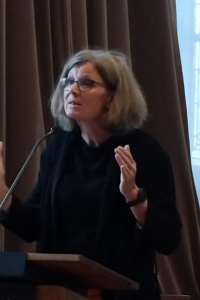
Style as a choice
On the first day, all researchers from the universities of Cambridge, Pisa, Paris and Leiden finally gathered to get to know each other and enjoy the first lecture by Professor Mari Hvattum of the Oslo School of Architecture and Design, who spoke on the understandings of Style within the work of Gottfried Semper, 19th century German architect and art critic (this interesting lecture can be watched on YouTube).
Hvattum explained that for Semper, style is a choice. It can make present many places and pasts through the continual transformation of initial motives that leave traces, and therefore always remain linked to (multiple) pasts. In this way, when we use certain styles we tap into a collective reservoir of ideas and imagery for your own needs, which counters the nationalistic understanding of styles emerging within and for one culture. As a choice, more specifically style is, then, a process of making.
This, of course, already gave us lots to think about and it particularly struck me how these ideas are re-emerging and current now, when we consider what styles can do to us – how they affect us. To see beyond the confined interpretations of styles belonging to ethnic cultures or nation-states and the problematics that accompany it, and to see them as multi-layered principles with an effect of their own. Sure enough, this was the point of the summer school.
Dinner in the museum
The day ended with a special dinner in the ‘Tempelzaal’ of the National Museum of Antiquities, where we could ponder the effect of the Temple of Taffeh looming large over the dining tables and its style on its audiences in the present while enjoying our meals.
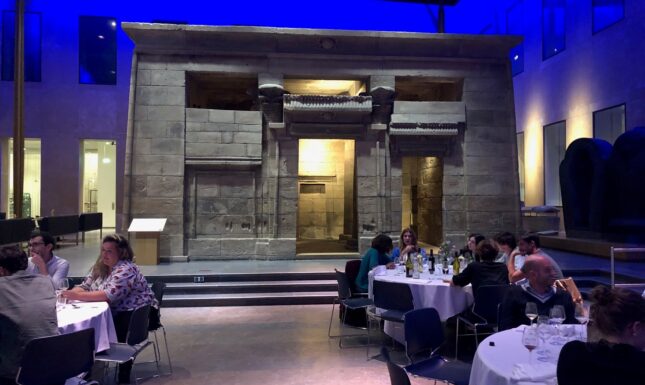
Not so summer-y
The next day started early, and the rain that morning made quite a number of us crack into jokes about how this ‘Summer School’ didn’t feel so summer-y after all. It gave the participants from abroad a nice experience of some classically typical Dutch weather, at least. Nevertheless, the attention was quickly shifted to the next lecture on the program, where Caroline van Eck spoke on style as camouflage, in relation to both artworks and phenomena in nature. This delved into the pervasive idea that art should be like nature and the deceptions and practices of camouflage inherent to it – such appearances hold agency in the way that they act on their audience.
This was followed by a succession of the group presentations we had to prepare, where all of us reflected on the agency of style with regards to our own very varied research topics. Think of Etruscan pottery, flowers in pre-modern French art and fashion, 19th century British architecture, Italian post-war monuments, Hegel’s analysis of Egyptian art, among the manifold of topics. An eclectic assortment of interesting ideas! In most of these talks, it became clear that style does affect people in various ways, for instance through implications of and allusions to the sensory (think of the depiction of sweet-smelling flowers), or of time (using specific styles associated with the past would evoke and make present this past in the viewer’s experience).
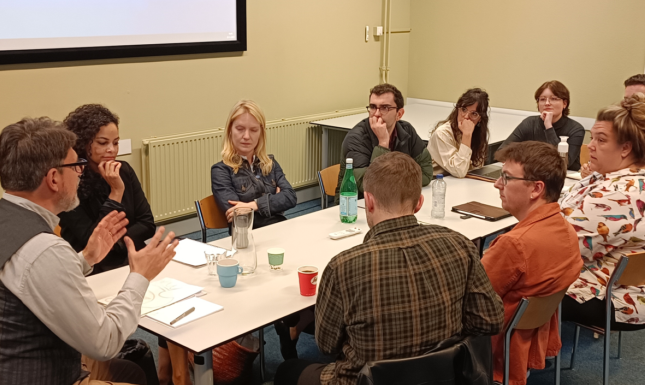
The perception of style
After all participants had given their presentations, the atmosphere was a bit more carefree the next day. Fighting our increasing fatigue, we still enjoyed a fascinating excursus into a more philosophical-oriented paper on the philosophy of art and of perception in relation to style, which gave us a thorough grounding in how style and ways of seeing have been approached through the years. One interesting point centered on our current desire to ‘get closer’ to things, such as pictures: we not only observe them but desire to touch and hold them, to interact (like we do on our touchscreen phones). Next up we got an overview of the art of the papal palaces in the Vatican City. Stijn Bussels followed suit by presenting to us his new and ongoing research into art and fashion in the France during the Age of Classicism, ca. 1750-1820, and how style, here, could help in shaping historical consciousness and the construction of historicity. The ‘classical’ as an idea and style began to play a big role in expressing national values, based on understandings of Roman Republican values. By dressing in the style of this historical period, the wearer and observer established immersion into an antique world, embodying it and making it present for contemporary (political) goals.
Finally, the series of lectures was topped off with a venture into antiquity itself by considering how Hellenistic styles played a role in the kingdom of Commagene, located in modern Türkiye. Its material culture is eclectic, but has puzzled scholars. It does not look entirely Greek, nor entirely local, but a bit of both. Professor Miguel John Versluys urged that styles were meant to act, and that they could do so via their associations of earlier uses. In that way, styles could be creatively used and updated in new contexts to express new messages that would resonate locally.

An understanding of style
All in all, these talks, discussions and lectures showcase a sweeping variety of what we can do with style(s), and how to try and understand them.
So, what is style? This is the most difficult question to answer, and no one who participated came up with a very clear answer. This goes to show that style is not just an objective feature to grasp, but that it hovers between individual experiences and collective norms, something we can see so clearly but which is hard to understand. It seems that style as a concept, throughout history, is still very much a work-in-progress with which more fruitful research can be done. If I were to try and offer an understanding of style, I would be inclined to follow Semper: Style is a practice, a process, an ordering, a choice.
About Museums, Collections & Society
The Summer School The Agency of Style was organised by Leiden University's research programme Museums, Collections & Society, together with Professor Stijn Bussels (Faculty of Humanities) and Professor Miguel John Versluys (Faculty of Archaeology). The research programme is led by the Faculty of Humanities and the Faculty of Archaeology and aims to promote collection-based research, stimulate Leiden education in this field, and raise ethical questions regarding the collections’ origins.
See for more information the website of Museums, Collections & Society.



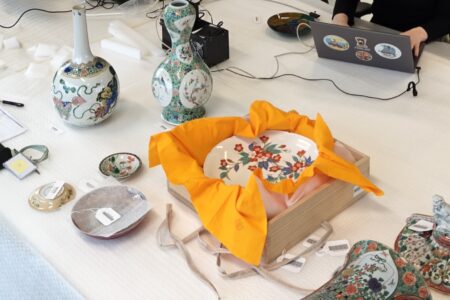
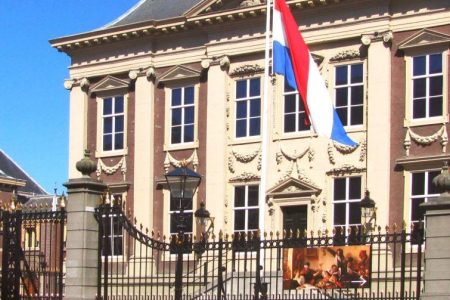
0 Comments